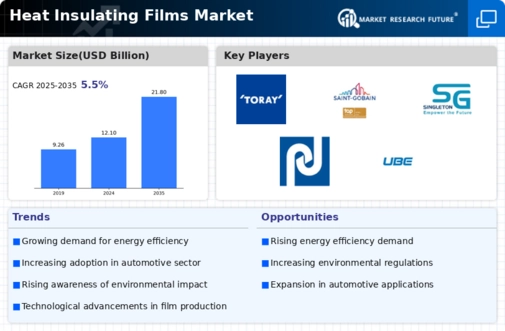Heat Insulating Films Size
Heat Insulating Films Market Growth Projections and Opportunities
The Heat Insulating Films market is significantly influenced by a variety of factors that collectively shape its dynamics within the construction, automotive, and energy efficiency sectors. One of the primary drivers behind the growth of the Heat Insulating Films market is the increasing emphasis on energy efficiency and sustainability in building and automotive design. Heat insulating films, also known as window films or tint films, play a crucial role in minimizing heat transfer through windows, reducing energy consumption for heating and cooling, and enhancing overall comfort. As awareness of energy conservation and environmental impact grows, the demand for heat insulating films rises across residential, commercial, and automotive applications.
The global Heat Insulating Films market is accounted to register a CAGR of 5.50% during the forecast period and is estimated to reach USD 16.67 billion by 2032.
Economic factors play a pivotal role in determining the demand for Heat Insulating Films. Economic growth, construction activities, and the automotive industry's expansion contribute to the demand for energy-efficient solutions. The construction sector, in particular, uses heat insulating films to meet energy efficiency standards and enhance the comfort of occupants. Conversely, economic downturns may lead to reduced construction and automotive activities, impacting the overall demand for heat insulating films.
Raw material prices and availability are critical factors influencing the Heat Insulating Films market. The key materials used in manufacturing heat insulating films, such as polyester, polyethylene, or metal coatings, are subject to market fluctuations. Changes in raw material prices, supply chain disruptions, and advancements in film technologies can impact the production cost of heat insulating films, influencing market dynamics. Manufacturers in the heat insulating film sector must closely monitor these factors to maintain a stable supply chain and competitive pricing.
Technological advancements contribute to the evolution of the Heat Insulating Films market. Ongoing research and development efforts focus on improving the thermal performance, optical clarity, and durability of heat insulating films. Innovations in nanotechnology and coatings enhance the heat-reflective properties of films, contributing to their effectiveness in controlling heat transfer. Manufacturers are also exploring smart film technologies that allow for adjustable transparency, providing an additional layer of control over light and heat entering a space.
Environmental regulations and sustainability considerations are increasingly shaping the Heat Insulating Films market. As awareness of environmental issues and carbon footprints rises, industries are under pressure to adopt cleaner and more sustainable practices. Heat insulating films, by reducing the need for excessive heating or cooling, align with energy conservation goals. Manufacturers are exploring eco-friendly materials and production processes to meet regulatory standards and appeal to environmentally conscious consumers.
Global market trends and trade dynamics also impact the Heat Insulating Films market. The interconnectedness of economies means that changes in one region can have cascading effects on the supply and demand for heat insulating films worldwide. Trade agreements, tariffs, and geopolitical events can influence the international trade of these films, affecting market conditions for manufacturers and distributors. Companies in the heat insulating film market need to stay informed about global dynamics to navigate potential challenges and capitalize on opportunities.
Consumer preferences and industry standards contribute to the market factors shaping the Heat Insulating Films industry. The demand for energy-efficient and aesthetically pleasing solutions aligns with changing consumer expectations. Manufacturers are adapting their heat insulating films to meet industry standards and consumer preferences, including options for different levels of tint, UV protection, and privacy features.



 Source: Secondary Research, Primary Research, Market Research Future Database and Analyst Review
Source: Secondary Research, Primary Research, Market Research Future Database and Analyst Review





Leave a Comment